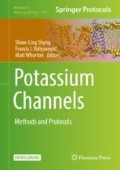Abstract
The gating of potassium ion (K+) channels is regulated by various kinds of protein-protein interactions (PPIs). Structural investigations of these PPIs provide useful information not only for understanding the gating mechanisms of K+ channels, but also for developing the pharmaceutical compounds targeting K+ channels. Here, we describe a nuclear magnetic resonance spectroscopic method, termed the cross saturation (CS) method, to accurately determine the binding surfaces of protein complexes, and its application to the investigation of the interaction between a G protein-coupled inwardly rectifying K+ channel and a G protein α subunit.
References
Barhanin J, Lesage F, Guillemare E et al (1996) KvLQT1 and IsK (minK) proteins associate to form the I KS cardiac potassium current. Nature 384:78–80
Sanguinetti MC, Curran ME, Zou A et al (1996) Coassembly of KVLQT1 and minK (IsK) proteins to form cardiac I KS potassium channel. Nature 384:80–83
Logothetis DE, Kurachi Y, Galper J et al (1987) The βγ subunits of GTP-binding proteins activate the muscarinic K+ channel in heart. Nature 325:321–326
Yokogawa M, Takeuchi K, Shimada I (2005) Bead-linked proteoliposomes: a reconstitution method for NMR analyses of membrane protein−ligand interactions. J Am Chem Soc 127:12021–12027
Yoshiura C, Kofuku Y, Ueda T et al (2010) NMR analyses of the interaction between CCR5 and its ligand using functional reconstitution of CCR5 in lipid bilayers. J Am Chem Soc 132:6768–6777
Kubo S, Nishida N, Udagawa Y et al (2013) A gel-encapsulated bioreactor system for NMR studies of protein-protein interactions in living mammalian cells. Angew Chem Int Ed Engl 52:1208–1211
Takahashi H, Nakanishi T, Kami K et al (2000) A novel NMR method for determining the interfaces of large protein-protein complexes. Nat Struct Biol 7:220–223
Shimada I, Ueda T, Matsumoto M et al (2009) Cross-saturation and transferred cross-saturation experiments. Prog NMR Spect 54:123–140
Ueda T, Takeuchi K, Nishida N et al (2014) Cross-saturation and transferred cross-saturation experiments. Q Rev Biophys 47:143–187
Takeuchi K, Yokogawa M, Matsuda T et al (2003) Structural basis of the KcsA K+ channel and agitoxin2 pore-blocking toxin interaction by using the transferred cross-saturation method. Structure 11:1381–1392
Ozawa S, Kimura T, Nozaki T et al (2015) Structural basis for the inhibition of voltage-dependent K+ channel by gating modifier toxin. Sci Rep 5:14226
Yokogawa M, Osawa M, Takeuchi K et al (2011) NMR analyses of the Gβγ binding and conformational rearrangements of the cytoplasmic pore of G protein-activated inwardly rectifying potassium channel 1 (GIRK1). J Biol Chem 286:2215–2223
Mase Y, Yokogawa M, Osawa M et al (2012) Structural basis for modulation of gating property of G protein-gated inwardly rectifying potassium ion channel (GIRK) by i/o-family G protein α subunit (Gαi/o). J Biol Chem 287:19537–19549
Pervushin K, Riek R, Wider G et al (1997) Attenuated T 2 relaxation by mutual cancellation of dipole-dipole coupling and chemical shift anisotropy indicates an avenue to NMR structures of very large biological macromolecules in solution. Proc Natl Acad Sci U S A 94:12366–12371
Nakanishi T, Miyazawa M, Sakakura M et al (2002) Determination of the interface of a large protein complex by transferred cross-saturation measurements. J Mol Biol 318:245–249
Kupce E, Wagner G (1995) Wideband homonuclear decoupling in protein spectra. J Magn Reson 109:329–333
Matsumoto M, Ueda T, Shimada I (2010) Theoretical analyses of the transferred cross-saturation method. J Magn Reson 205:114–124
Mase Y, Yokogawa M, Osawa M et al (2012) Backbone resonance assignments for G protein αi3 subunit in the GTP-bound state. Biomol NMR Assign 6:217–220
Ueda T, Yoshiura C, Matsumoto M et al (2015) Development of a method for reconstruction of crowded NMR spectra from undersampled time-domain data. J Biomol NMR 62:31–41
Yoshiura C, Ueda T, Kofuku Y et al (2015) Elucidation of the CCR1- and CCR5-binding modes of MIP-1α by application of an NMR spectra reconstruction method to the transferred cross-saturation experiments. J Biomol NMR 63:333–340
Geen H, Freeman R (1991) Band-selective radiofrequency pulses. J Magn Reson 93:93–141
Takahashi H, Miyazawa M, Ina Y et al (2006) Utilization of methyl proton resonances in cross-saturation measurement for determining the interfaces of large protein–protein complexes. J Biomol NMR 34:167–177
Igarashi S, Osawa M, Takeuchi K et al (2008) Amino acid selective cross-saturation method for identification of proximal residue pairs in a protein−protein complex. J Am Chem Soc 130:12168–12176
de Vries SJ, van Dijk M, Bonvin AMJJ (2010) The HADDOCK web server for data-driven biomolecular docking. Nat Protoc 5:883–897
Zhu G, Kong XM, Sze KH (1999) Gradient and sensitivity enhancement of 2D TROSY with water flip-back, 3D NOESY-TROSY and TOCSY-TROSY experiments. J Biomol NMR 13:77–81
Acknowledgments
This work was supported in part by grants from the Japan New Energy and Industrial Technology Development Organization (NEDO) and the Ministry of Economy, Trade, and Industry (METI) (to I.S.), a Grant-in-Aid for Scientific Research on Priority Areas from the Japanese Ministry of Education, Culture, Sports, Science, and Technology (MEXT) (to I.S.), the Development of core technologies for innovative drug development based upon IT from Japan Agency for Medical Research and development, AMED (to I.S.), JSPS KAKENHI Grant Number JP16H01368 (to M.O.), a grant from The Vehicle Racing Commemorative Foundation (to M.O.), and a grant from Nagase Science Technology Foundation (to M.O.).
Author information
Authors and Affiliations
Corresponding author
Editor information
Editors and Affiliations
Rights and permissions
Copyright information
© 2018 Springer Science+Business Media LLC
About this protocol
Cite this protocol
Toyama, Y., Mase, Y., Kano, H., Yokogawa, M., Osawa, M., Shimada, I. (2018). Nuclear Magnetic Resonance Approaches for Characterizing Protein-Protein Interactions. In: Shyng, SL., Valiyaveetil, F., Whorton, M. (eds) Potassium Channels. Methods in Molecular Biology, vol 1684. Humana Press, New York, NY. https://doi.org/10.1007/978-1-4939-7362-0_10
Download citation
DOI: https://doi.org/10.1007/978-1-4939-7362-0_10
Published:
Publisher Name: Humana Press, New York, NY
Print ISBN: 978-1-4939-7361-3
Online ISBN: 978-1-4939-7362-0
eBook Packages: Springer Protocols

